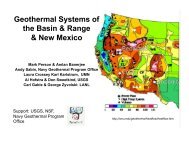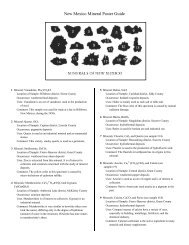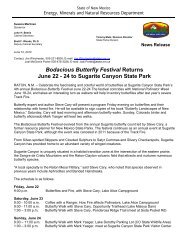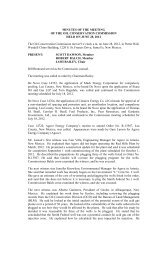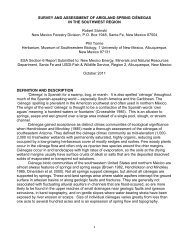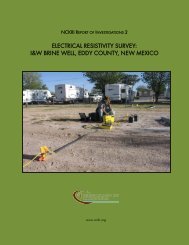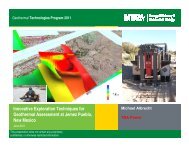Annual Report 3 - New Mexico - Energy, Minerals and Natural ...
Annual Report 3 - New Mexico - Energy, Minerals and Natural ...
Annual Report 3 - New Mexico - Energy, Minerals and Natural ...
Create successful ePaper yourself
Turn your PDF publications into a flip-book with our unique Google optimized e-Paper software.
In 2004, ECMD facilitated the installation of the nation’s first multiple biofuels station in Santa Fe. The station<br />
dispenses B20 bio-diesel (diesel blended with 20 percent biodiesel) <strong>and</strong> two blends of ethanol (E10, E85). Also in<br />
2004, ECMD helped enact a five-year Motor Vehicle Excise Tax exemption for hybrid-electric vehicles, thereby<br />
saving <strong>New</strong> Mexicans $600 to $900 on the purchase of a gasoline-electric hybrid.<br />
Over the past eight years, ECMD provided financial support to <strong>and</strong> worked closely with the L<strong>and</strong> of Enchantment<br />
Clean Cities Coalition which, as part of the national organization, helped achieve a remarkable milestone in 2005:<br />
displacement of more than one billion gallons of gasoline since inception of the program. Our program works<br />
closely with L<strong>and</strong> of Enchantment Clean Cities Coalition to promote efficient transportation, advanced power-train<br />
technologies <strong>and</strong> cleaner-burning alternative <strong>and</strong> renewable fuels.<br />
In 2008, ECMD provided funds for the City of Santa Fe Parking Division to purchase two electric vehicles for use in<br />
daily parking enforcement patrols. A photovoltaic solar project funded by ECMD at Albuquerque Sunport produces<br />
power for electric vehicles used at the airport.<br />
The <strong>Energy</strong> Innovation Fund has provided over $2 million to the City of Carlsbad, partnered with the Center of<br />
Excellence for Hazardous Materials Management, for a project to introduce microalgae into test ponds. This project<br />
will determine the potential of microalgae reproduction for biodiesel oil production <strong>and</strong> test the quality of the oil<br />
in order to meet motor fuel st<strong>and</strong>ards. The project plans to assess the availability of this natural resource <strong>and</strong> the<br />
feasibility of an algae biodiesel industry in <strong>New</strong> <strong>Mexico</strong>.<br />
CLEAN ENERGY PROJECTS PROGRAM: The Clean <strong>Energy</strong> Projects (CEP) program<br />
was established pursuant to legislation passed in 2004 <strong>and</strong> has since provided $5 million in state funding for capital<br />
projects on a competitive basis to public entities. Recipients include municipalities, counties, state agencies, colleges<br />
<strong>and</strong> universities, tribal <strong>and</strong> pueblo governments, <strong>and</strong> public schools (K-12). Clean energy projects include those<br />
related to renewable energy (solar, wind, geothermal, biomass), energy efficiency in transportation or in governmental<br />
buildings, <strong>and</strong> clean burning transportation fuels such as CNG, ethanol, <strong>and</strong> biodiesel. Scores of demonstration<br />
projects of clean energy technologies have been funded using commercially-available technology.<br />
The CEP program offers a variety of benefits to participating public entities, starting with reducing existing energy<br />
usage in a facility or fleet by an average of 15 percent. Solar systems for schools throughout the state are reducing<br />
utility bills, as well as providing new resources for teachers <strong>and</strong> educational opportunities for our children. The<br />
Village of Angel Fire installed a biodiesel production facility, using restaurant grease waste, as a local fuel source<br />
for its municipal fleet. The Department of Transportation initiated a traffic signal retrofit that positioned the state<br />
for quick takeoff with the federal stimulus funding, exp<strong>and</strong>ing the project tenfold. The City of Santa Fe analyzed<br />
its waste at the wastewater treatment plant <strong>and</strong> found that gas byproducts could be used to fire its process heating<br />
needs. The City of Belen utilized concentrating solar technology with two small Stirling dish engine units to provide<br />
most of its City Hall’s electricity needs. Las Cruces Public Schools incorporated a geothermal heat pump system into<br />
a new school design to reduce heating, cooling, <strong>and</strong> electricity needs.<br />
ANNUAL REPORT 2010<br />
39




